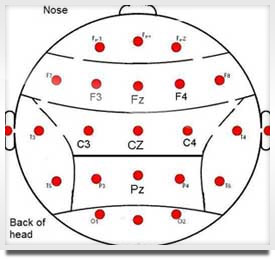How to change sleep quickly
Let’s say you often take an hour to fall asleep. Or that it’s difficult to wake up. Can that be changed quickly, even if it’s a long-term pattern in your life?
With neurofeedback training, changes in sleep are usually the first thing people notice. Almost every clinician notes this with the vast majority. It’s not unusual to hear reports of changes within one, two or three 30-minute brain training sessions. We’ve seen many notice changes within a 15-minute session if they are sensitive to training. The effects will not last after just one session, and with continued training, the brain learns the new pattern, and you can influence longer term changes in sleep.
 Activation: Put the electrode at C3 (see chart). Train the person at that site for 30 minutes at 15-18 hz, which is a frequency that activates. That means the client is rewarded when they make more of the 15-18 hz EEG amplitude. More beeps lets you know you’re doing well.
Activation: Put the electrode at C3 (see chart). Train the person at that site for 30 minutes at 15-18 hz, which is a frequency that activates. That means the client is rewarded when they make more of the 15-18 hz EEG amplitude. More beeps lets you know you’re doing well.
This training usually produces a more alert, awake, activated state. That training tends to help people who struggle to get up in morning wake up more quickly. It can also affect other patterns.
Fall asleep faster by doing right-side training. Training C4 at 12-15 hz tends to be a calming frequency. If someone takes an hour to quiet their mind or body enough to fall asleep, this training will often help them fall asleep much faster. Think of C4 12-15 hz as quieting the system down. As their brain learns that pattern, they are helping their brain to learn to shift gears and quiet itself more quickly. It’s remarkable how fast the brain can learn and respond to this pattern.
Training the wrong frequency can also affect sleep. Given what you’ve read, what might happen if you trained C3 for 30 minutes at 15-18 hz (activation) on someone who has a hard time slowing down at night. Could it make it HARDER to fall asleep? You bet. And it does. So if you don’t carefully assess your client, you might initially train the wrong side. Of course, you’ll both know by the next visit to switch things around.
If you train someone who struggles to wake in the morning for 30 minutes at C4 12-15 hz reward, lo and behold, he or she could have a much harder time waking in the morning.
On rare occasions, people who come to neurofeedback courses scoff at the idea of such a fast change and believe it’s a placebo effect. The experiences and results speak for themselves.

